Deck 18: Creating a Democratic Paradise: The Progressive Era, 1895-1915
Question
Question
Question
Question
Question
Question
Question
Question
Question
Question
Question
Question
Question
Question
Question
Question
Question
Question
Question
Question
Question
Question
Question
Question
Question
Question
Question
Question
Question
Question
Question
Question
Question
Question
Question
Question
Question
Question
Question
Question
Question
Question
Question
Question
Question
Question
Question
Question
Question
Question

Unlock Deck
Sign up to unlock the cards in this deck!
Unlock Deck
Unlock Deck
1/50
Play
Full screen (f)
Deck 18: Creating a Democratic Paradise: The Progressive Era, 1895-1915
1
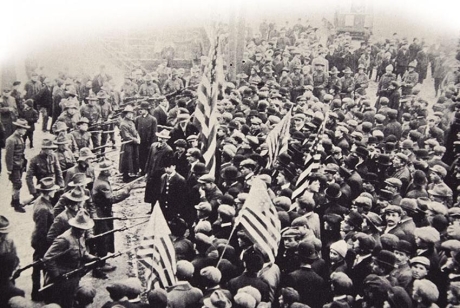
What was the immediate Progressive reaction to this 1912 photograph depicting a stand-off between the state militia and striking textile workers in Lawrence, Massachusetts?
A) They developed greater sympathy for working-class immigrants.
B) They were fearful that the strike would turn violent.
C) They wanted to find a legal way to curb the power of big business.
D) They sought ways to give labor unions more power over their employers.
They were fearful that the strike would turn violent.
2
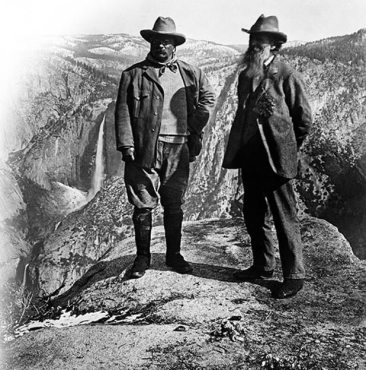
What were the positions held by President Theodore Roosevelt and naturalist John Muir, who are shown on a camping trip in Yosemite in this 1903 photograph, regarding nature and natural resources?
A) Both Muir and Roosevelt upheld conservationist beliefs that nature was meant to support economic needs while also being preserved for the future.
B) Both Muir and Roosevelt were preservationists who believed that nature should remain untouched.
C) Muir believed that nature should be preserved in its unspoiled state, while Roosevelt believed it should be conserved to meet present economic needs and be around for the future.
D) Roosevelt upheld the preservationist viewpoint of nature in its unspoiled state, while Muir favored conservation for economic benefits.
Muir believed that nature should be preserved in its unspoiled state, while Roosevelt believed it should be conserved to meet present economic needs and be around for the future.
3
What did the Federal Reserve Act, Clayton Anti-Trust Act, and the Federal Trade Commission have in common?
A) They were all socialist policies approved by President Wilson during his term in office.
B) They were all Progressive measures rejected by Theodore Roosevelt for not doing enough to help workers.
C) They were all pro-business conservative legislation approved by President Taft.
D) They were all Progressive measures passed by the Wilson administration to reform banking and big business.
A) They were all socialist policies approved by President Wilson during his term in office.
B) They were all Progressive measures rejected by Theodore Roosevelt for not doing enough to help workers.
C) They were all pro-business conservative legislation approved by President Taft.
D) They were all Progressive measures passed by the Wilson administration to reform banking and big business.
They were all Progressive measures passed by the Wilson administration to reform banking and big business.
4
What does the term Progressivism best describe?
A) a criticism that the poor were in that condition because of their selfish pursuit of pleasure
B) a radical political ideal that private property should be eliminated
C) a shared philosophical approach to solve issues that threatened middle-class values
D) a belief in individualism that made each man responsible for his wealth or poverty
A) a criticism that the poor were in that condition because of their selfish pursuit of pleasure
B) a radical political ideal that private property should be eliminated
C) a shared philosophical approach to solve issues that threatened middle-class values
D) a belief in individualism that made each man responsible for his wealth or poverty

Unlock Deck
Unlock for access to all 50 flashcards in this deck.
Unlock Deck
k this deck
5
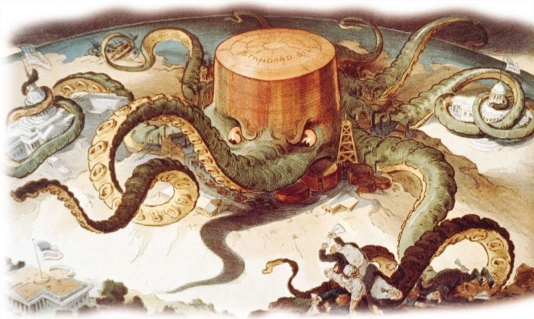
What did the illustrator of this cartoon imply by depicting Standard Oil as an octopus grabbing many different people and objects?
A) Standard Oil's practice of vertical integration was an efficient way of eliminating competition.
B) Standard Oil was trying to gain the same control of the presidency as it had done with Congress and the courts.
C) John D. Rockefeller was a benevolent entrepreneur whose philanthropy helped the nation.
D) Standard Oil was planning to invest in off-shore drilling.

Unlock Deck
Unlock for access to all 50 flashcards in this deck.
Unlock Deck
k this deck
6
What did Progressives mean when they referred to "municipal housekeeping"?
A) Women had earned the right to vote.
B) Women were responsible for promoting Christian charity to help the poor.
C) Women were placed in charge of promoting legislation to ban alcohol and vice.
D) Women could not adequately protect their children without government assistance.
A) Women had earned the right to vote.
B) Women were responsible for promoting Christian charity to help the poor.
C) Women were placed in charge of promoting legislation to ban alcohol and vice.
D) Women could not adequately protect their children without government assistance.

Unlock Deck
Unlock for access to all 50 flashcards in this deck.
Unlock Deck
k this deck
7
What did journalist Ida Tarbell reveal in her exposé of Standard Oil?
A) illicit deals between John D. Rockefeller and railroad companies
B) the economic benefits of trusts, such as stabilized prices
C) John D. Rockefeller's attempt to broker a backroom deal with the president
D) the failure of the government's trustbusting efforts against the company
A) illicit deals between John D. Rockefeller and railroad companies
B) the economic benefits of trusts, such as stabilized prices
C) John D. Rockefeller's attempt to broker a backroom deal with the president
D) the failure of the government's trustbusting efforts against the company

Unlock Deck
Unlock for access to all 50 flashcards in this deck.
Unlock Deck
k this deck
8
President Wilson offset the lost revenues resulting from his cut to the tariff by relying on
A) monies brought in by direct taxation on the states
B) private donations from the wealthy
C) a large tax on the wealthiest companies
D) revenue created by the first federal income tax
A) monies brought in by direct taxation on the states
B) private donations from the wealthy
C) a large tax on the wealthiest companies
D) revenue created by the first federal income tax

Unlock Deck
Unlock for access to all 50 flashcards in this deck.
Unlock Deck
k this deck
9
When a female trade-union activist stated that "children need pure milk and good food, good schools and playgrounds, sanitary homes and safe streets," she was implying that this could only happen if .
A) the middle class supported Christian charities
B) alcohol and vice were illegalized and eliminated
C) women received the right to vote
D) the settlement house movement received greater financial support
A) the middle class supported Christian charities
B) alcohol and vice were illegalized and eliminated
C) women received the right to vote
D) the settlement house movement received greater financial support

Unlock Deck
Unlock for access to all 50 flashcards in this deck.
Unlock Deck
k this deck
10
What Progressive message did artist and eyewitness Victor Gatto convey in his painting
Triangle Fire: March 25, 1911?
A) Big business was sympathetic to the plights of the urban worker.
B) The government did not have the power to protect workers.
C) First responders had effective systems in place when dealing with emergencies.
D) Early twentieth-century legislation gave women greater opportunities in the labor force.
Triangle Fire: March 25, 1911?
A) Big business was sympathetic to the plights of the urban worker.
B) The government did not have the power to protect workers.
C) First responders had effective systems in place when dealing with emergencies.
D) Early twentieth-century legislation gave women greater opportunities in the labor force.

Unlock Deck
Unlock for access to all 50 flashcards in this deck.
Unlock Deck
k this deck
11
How did Theodore Roosevelt and his successor William Howard Taft differ in their dealings with trusts?
A) Roosevelt believed all trusts were "bad," while Taft believed that only some of them needed to be controlled.
B) Roosevelt took the side of laborers, while Taft sided with industrial employers.
C) Roosevelt believed in "good" and "bad" trusts, while Taft believed all trusts needed to be broken up.
D) Roosevelt used federal troops to support trusts' interests during strikes, while Taft sent in troops to support workers' interests.
A) Roosevelt believed all trusts were "bad," while Taft believed that only some of them needed to be controlled.
B) Roosevelt took the side of laborers, while Taft sided with industrial employers.
C) Roosevelt believed in "good" and "bad" trusts, while Taft believed all trusts needed to be broken up.
D) Roosevelt used federal troops to support trusts' interests during strikes, while Taft sent in troops to support workers' interests.

Unlock Deck
Unlock for access to all 50 flashcards in this deck.
Unlock Deck
k this deck
12
How did Progressives react to oil tycoon John D. Rockefeller's statement that "failures which a man makes in his life are due almost to some defect in his personality, some weakness of body, mind, or character, will, or temperament"?
A) They believed the rich had rejected the values that prevented individualism from turning into selfishness.
B) They worried that the growing divide between the "haves" and "have-nots" put them in a precarious position.
C) They were concerned that a classless paradise without private property would lead to the loss of their homes and small businesses.
D) They wanted to find a way to end both industrial exploitation and the steady stream of strikes that disrupted their daily lives.
A) They believed the rich had rejected the values that prevented individualism from turning into selfishness.
B) They worried that the growing divide between the "haves" and "have-nots" put them in a precarious position.
C) They were concerned that a classless paradise without private property would lead to the loss of their homes and small businesses.
D) They wanted to find a way to end both industrial exploitation and the steady stream of strikes that disrupted their daily lives.

Unlock Deck
Unlock for access to all 50 flashcards in this deck.
Unlock Deck
k this deck
13
As a result of the Triangle Shirtwaist Factory Fire, .
A) women across all classes fought for city safety regulations
B) working-class men insisted that their wives and daughters should not work
C) industrialists built safer buildings and instituted less exploitative practices
D) firefighters and police officers were recognized as heroes
A) women across all classes fought for city safety regulations
B) working-class men insisted that their wives and daughters should not work
C) industrialists built safer buildings and instituted less exploitative practices
D) firefighters and police officers were recognized as heroes

Unlock Deck
Unlock for access to all 50 flashcards in this deck.
Unlock Deck
k this deck
14
What made President Theodore Roosevelt's position on the 1902 coal strike in Pennsylvania unique from previous presidential policies regarding labor interests?
A) He stood up publicly to big business and helped negotiate better conditions for laborers.
B) His order of sending in federal troops to break up a strike was the first time this was done by a president.
C) He broke up the trust that coal mine owners had set up to protect workers' interests.
D) He filed a lawsuit in federal court against the mine owners.
A) He stood up publicly to big business and helped negotiate better conditions for laborers.
B) His order of sending in federal troops to break up a strike was the first time this was done by a president.
C) He broke up the trust that coal mine owners had set up to protect workers' interests.
D) He filed a lawsuit in federal court against the mine owners.

Unlock Deck
Unlock for access to all 50 flashcards in this deck.
Unlock Deck
k this deck
15
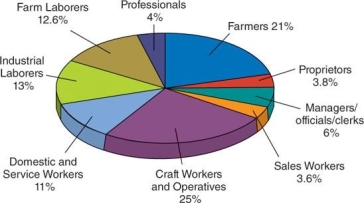
What was the likely relationship between Progressive values and the occupations of most Americans, as seen in the pie chart?
A) The middle-class values of Progressives may not have reflected those of a largely working- class America.
B) The mainstream values of Progressives may not have reflected those of a largely immigrant population.
C) The elitist values of Progressives may not have reflected those of the large portion of Americans who had to work for a living.
D) The idealistic values of Progressives may not have reflected those of workers striving to make more money.

Unlock Deck
Unlock for access to all 50 flashcards in this deck.
Unlock Deck
k this deck
16
What trust controlled by J.P. Morgan did Theodore Roosevelt break up in 1904 for threatening public interests through consolidation??
A) Singer Sewing Machine
B) U.S. Steel
C) Standard Oil
D) Northern Securities
A) Singer Sewing Machine
B) U.S. Steel
C) Standard Oil
D) Northern Securities

Unlock Deck
Unlock for access to all 50 flashcards in this deck.
Unlock Deck
k this deck
17
Proponents of the Social Gospel like Protestant minister Josiah Strong believed that
A) they had a duty to proselytize and spread their religion
B) the working poor were to blame for their predicament
C) people of different religious faiths should live in harmony
D) Christians had a responsibility to address social problems
A) they had a duty to proselytize and spread their religion
B) the working poor were to blame for their predicament
C) people of different religious faiths should live in harmony
D) Christians had a responsibility to address social problems

Unlock Deck
Unlock for access to all 50 flashcards in this deck.
Unlock Deck
k this deck
18
Progressive reforms during the early twentieth century were led mostly by members of the
A) working class
B) Socialist Party
C) upper class and business elite
D) middle class
A) working class
B) Socialist Party
C) upper class and business elite
D) middle class

Unlock Deck
Unlock for access to all 50 flashcards in this deck.
Unlock Deck
k this deck
19
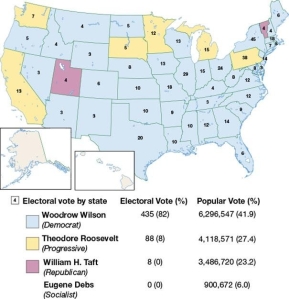
What does this map imply about the 1912 presidential election?
A) The majority of Americans supported the move to set up government-run monopolies.
B) Nearly 70 percent of all voters endorsed Progressive principles and reforms.
C) Third-party candidates played a minor role in this election.
D) Voters were more interested in conservative values rather than Progressive reforms.

Unlock Deck
Unlock for access to all 50 flashcards in this deck.
Unlock Deck
k this deck
20
How did Woodrow Wilson's "New Freedom" differ from Theodore Roosevelt's "New Nationalism" program?
A) The "New Freedom" wanted to focus more on success for small businesses, while the "New Nationalism" wanted to regulate but not destroy big business.
B) The "New Freedom" opposed tariffs, while the "New Nationalism" supported them.
C) The "New Freedom" wanted government-owned monopolies, while the "New Nationalism" called for trust-busting.
D) The "New Freedom" supported laborers, while the "New Nationalism" supported industrialists.
A) The "New Freedom" wanted to focus more on success for small businesses, while the "New Nationalism" wanted to regulate but not destroy big business.
B) The "New Freedom" opposed tariffs, while the "New Nationalism" supported them.
C) The "New Freedom" wanted government-owned monopolies, while the "New Nationalism" called for trust-busting.
D) The "New Freedom" supported laborers, while the "New Nationalism" supported industrialists.

Unlock Deck
Unlock for access to all 50 flashcards in this deck.
Unlock Deck
k this deck
21
What ultimately resulted in a decline in child labor?
A) mandatory school attendance
B) legislation by the Progressive era Congress
C) the decreasing population of young children
D) lower wages paid to children
A) mandatory school attendance
B) legislation by the Progressive era Congress
C) the decreasing population of young children
D) lower wages paid to children

Unlock Deck
Unlock for access to all 50 flashcards in this deck.
Unlock Deck
k this deck
22
How did innovations that Henry Ford developed or improved like the assembly line and standardized parts benefit the automobile industry?
A) A wide variety of cars in different styles and colors were produced by the Ford Motor Company.
B) Workers were paid higher wages but worked longer hours so that they could afford to buy cars.
C) More cars were produced for less money and then sold for cheaper rates.
D) Workers had greater opportunities to organize a union at Ford Motor Company.
A) A wide variety of cars in different styles and colors were produced by the Ford Motor Company.
B) Workers were paid higher wages but worked longer hours so that they could afford to buy cars.
C) More cars were produced for less money and then sold for cheaper rates.
D) Workers had greater opportunities to organize a union at Ford Motor Company.

Unlock Deck
Unlock for access to all 50 flashcards in this deck.
Unlock Deck
k this deck
23
How did capitalists respond to Ohio Senator Mark Hanna's request that industrialists should turn labor into "the ally of the capitalist, rather than a foe"?
A) Most industrialists refused to compromise their authority and implemented more antiunion policies.
B) Most industrialists willingly met with labor leaders and mutually agreed to better workers' benefits.
C) Labor leaders turned down industrialists' compromises because they wanted to keep the strike as a measure of negotiation.
D) Industrialists gave labor leaders the authority to establish "closed shops" where all workers had to join the union.
A) Most industrialists refused to compromise their authority and implemented more antiunion policies.
B) Most industrialists willingly met with labor leaders and mutually agreed to better workers' benefits.
C) Labor leaders turned down industrialists' compromises because they wanted to keep the strike as a measure of negotiation.
D) Industrialists gave labor leaders the authority to establish "closed shops" where all workers had to join the union.

Unlock Deck
Unlock for access to all 50 flashcards in this deck.
Unlock Deck
k this deck
24
How did laundry owner Curt Muller, who argued that current law deprived his workers of the right to control their own labor, react to the Supreme Court's decision in Muller v. Oregon?
A) He lowered the maximum hour rate for his female employees.
B) He fired all his female employees and replaced them with Chinese men.
C) He instituted more beneficial health and disability qualities for his female employees.
D) He hired a larger number of women to work in his laundry.
A) He lowered the maximum hour rate for his female employees.
B) He fired all his female employees and replaced them with Chinese men.
C) He instituted more beneficial health and disability qualities for his female employees.
D) He hired a larger number of women to work in his laundry.

Unlock Deck
Unlock for access to all 50 flashcards in this deck.
Unlock Deck
k this deck
25

Why did photographer Edward Curtis choose to portray many of the Native Americans, such as these Crow warriors, as figures riding off into the distance in his ethnographic project The North American Indian?
A) He wanted to publicize their skills as horsemen.
B) He wanted to show that many Indian cultures were already on the verge of disappearing.
C) He wanted to capture the variety and richness of Native American culture.
D) He wanted to keep the public aware of the problems related to forced assimilation.

Unlock Deck
Unlock for access to all 50 flashcards in this deck.
Unlock Deck
k this deck
26

How does Jessie Willcox Smith's illustration from her 1909 book The Seven Ages of Childhood contradict what working-class children between the ages of 10 through 15 were experiencing in the early twentieth century?
A) Health rates for young children were essentially better than what is illustrated in this image.
B) Children like the five-year-old in the picture actually spent more time in school than at home.
C) Children had healthier dietary habits that went beyond eating bowls of porridge.
D) Over 1.75 million children were working in factories, home sweatshops, or farms at this time.

Unlock Deck
Unlock for access to all 50 flashcards in this deck.
Unlock Deck
k this deck
27
What preferred method did labor leaders use to try to ensure that health and family benefits offered by employers not be eliminated during times of economic downturn?
A) strikes
B) court injunctions
C) turning to government regulation
D) collective bargaining
A) strikes
B) court injunctions
C) turning to government regulation
D) collective bargaining

Unlock Deck
Unlock for access to all 50 flashcards in this deck.
Unlock Deck
k this deck
28
What was the general implication taken from the U.S. Supreme Court's statement "as healthy mothers are essential to vigorous offspring, the physical well-being of a woman becomes the object of public interest and care in order to preserve the strength and vigor of the race" in its decision in the 1908 case of Muller v. Oregon?
A) Working women were given paid maternity leave for six weeks.
B) Feminists who believed in total equality were satisfied with the Court's ruling.
C) Working women and Progressive women developed a "blacklist" of businesses that did not support women's equality.
D) Women won shorter working hours because the Court believed they were biologically inferior to men.
A) Working women were given paid maternity leave for six weeks.
B) Feminists who believed in total equality were satisfied with the Court's ruling.
C) Working women and Progressive women developed a "blacklist" of businesses that did not support women's equality.
D) Women won shorter working hours because the Court believed they were biologically inferior to men.

Unlock Deck
Unlock for access to all 50 flashcards in this deck.
Unlock Deck
k this deck
29
What did novelist Upton Sinclair mean when he stated that he "…aimed for the public's heart, and by accident…hit it in the stomach," when he was referring to his novel The Jungle?
A) Rather than focusing on the concerns raised by the meat-packing industry, the public was more concerned about the negative impact of socialism.
B) The public misinterpreted Sinclair's intent about capitalism and mistook it for an endorsement of socialism.
C) Sinclair's novel meant to address how socialism was the only way to eliminate worker exploitation but instead shocked readers with his descriptions of the meat-packing industry.
D) President Roosevelt banned this novel after reading it because he felt the details were too scandalous.
A) Rather than focusing on the concerns raised by the meat-packing industry, the public was more concerned about the negative impact of socialism.
B) The public misinterpreted Sinclair's intent about capitalism and mistook it for an endorsement of socialism.
C) Sinclair's novel meant to address how socialism was the only way to eliminate worker exploitation but instead shocked readers with his descriptions of the meat-packing industry.
D) President Roosevelt banned this novel after reading it because he felt the details were too scandalous.

Unlock Deck
Unlock for access to all 50 flashcards in this deck.
Unlock Deck
k this deck
30
Why did many labor unions oppose the use of child labor in the workplace?
A) Child labor drove down adult wages.
B) Children had better opportunities to learn job skills in vocational schools rather than factories.
C) Children were only paid half or less of the wages earned by adults.
D) Children would be healthier if they worked outdoors on farms rather than indoors.
A) Child labor drove down adult wages.
B) Children had better opportunities to learn job skills in vocational schools rather than factories.
C) Children were only paid half or less of the wages earned by adults.
D) Children would be healthier if they worked outdoors on farms rather than indoors.

Unlock Deck
Unlock for access to all 50 flashcards in this deck.
Unlock Deck
k this deck
31
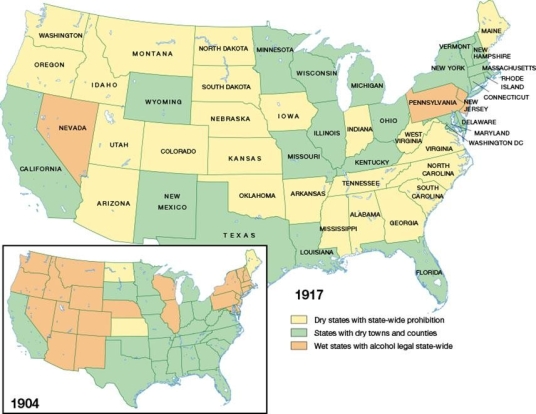
What factor contributed most to a shift from "wet" to "dry" states in the American West between 1904 and 1917?
A) growing problems with alcohol abuse by American Indians
B) women's acquisition of suffrage in the West before passage of the Nineteenth Amendment
C) the rise in violent crime and prostitution in Western cities due to alcohol
D) the increase in domestic violence resulting from the use of alcohol

Unlock Deck
Unlock for access to all 50 flashcards in this deck.
Unlock Deck
k this deck
32
What was one drawback of Frederick Winslow Taylor's scientific management system used at Ford Motor Company to promote efficiency?
A) eliminating workers' independence and creativity
B) speeding up the production process
C) increasing the mechanization of factories
D) providing more autonomy for the factory laborer
A) eliminating workers' independence and creativity
B) speeding up the production process
C) increasing the mechanization of factories
D) providing more autonomy for the factory laborer

Unlock Deck
Unlock for access to all 50 flashcards in this deck.
Unlock Deck
k this deck
33
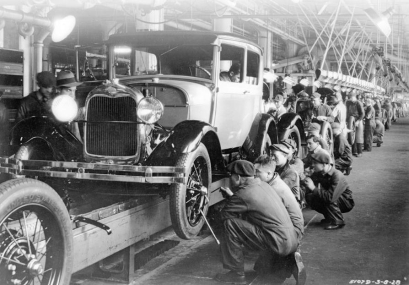
How does this photograph of a Ford assembly line reflect Henry Ford's statement that "the men do their work and go home-a factory is not a drawing room"?
A) Ford established a rule prohibiting workers from talking to each other on the assembly line.
B) Ford neglected his workers by not furnishing them with company-owned homes.
C) Ford believed that employers did not have a right to interfere in their employees' private lives.
D) Ford offered benefits only to certain men who met specific moral criteria.

Unlock Deck
Unlock for access to all 50 flashcards in this deck.
Unlock Deck
k this deck
34
Why were Progressives concerned about radical trade unions like the Industrial Workers of the World?
A) The IWW's goal was to create "one big union" that welcomed all workers.
B) The IWW's key objective was to abolish private property and formal government.
C) The IWW launched sympathy boycotts to support fellow workers on strike.
D) The IWW used its economic power of collective bargaining to negotiate with employers.
A) The IWW's goal was to create "one big union" that welcomed all workers.
B) The IWW's key objective was to abolish private property and formal government.
C) The IWW launched sympathy boycotts to support fellow workers on strike.
D) The IWW used its economic power of collective bargaining to negotiate with employers.

Unlock Deck
Unlock for access to all 50 flashcards in this deck.
Unlock Deck
k this deck
35
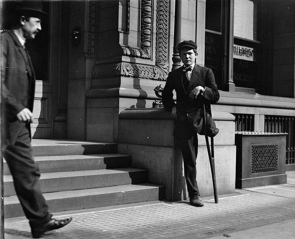
How did Lewis Hines's investigation of injured Pittsburgh workers that used photographs like this one of a young coal miner amputee help advance Progressive goals?
A) Employers paid immediate hospital expenses for the injured, but then let them fend for their selves.
B) Employers established medical practices and hospitals in their company towns.
C) States launched worker compensation programs that provided disability payments and medical care to the injured.
D) The wealthy instituted private charitable foundations to help injured workers survive.

Unlock Deck
Unlock for access to all 50 flashcards in this deck.
Unlock Deck
k this deck
36
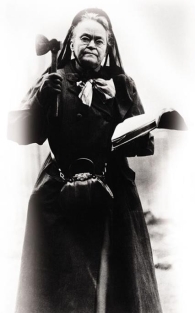
What type of emotion might saloonkeepers and their clients have felt when they saw prohibitionist Carry A. Nation in costume and with hatchet as she would march into saloons?
A) humor
B) religious devotion
C) fear
D) strength

Unlock Deck
Unlock for access to all 50 flashcards in this deck.
Unlock Deck
k this deck
37
The Slaughter-House cases (1874) and Lochner v. New York (1905) were anti-Progressive cases in which the U.S. Supreme Court struck down .
A) labor's right to negotiate wages with employers
B) workers' membership and participation in unions
C) pro-union strikes and boycotts
D) employees' requests for shorter working hours
A) labor's right to negotiate wages with employers
B) workers' membership and participation in unions
C) pro-union strikes and boycotts
D) employees' requests for shorter working hours

Unlock Deck
Unlock for access to all 50 flashcards in this deck.
Unlock Deck
k this deck
38
How did the 1914 Ludlow Massacre that ended with the deaths of 13 women and children after Colorado state troops set fire to their camp reveal about the shortcomings of the Progressive movement?
A) Unions realized that they needed more than just government support to solve their problems.
B) Industrialists continued to fail to provide company housing for their workers.
C) Members of similar unions remained disunited when it came to supporting their comrades.
D) The media remained insensitive to tragic situations like the Ludlow Massacre.
A) Unions realized that they needed more than just government support to solve their problems.
B) Industrialists continued to fail to provide company housing for their workers.
C) Members of similar unions remained disunited when it came to supporting their comrades.
D) The media remained insensitive to tragic situations like the Ludlow Massacre.

Unlock Deck
Unlock for access to all 50 flashcards in this deck.
Unlock Deck
k this deck
39
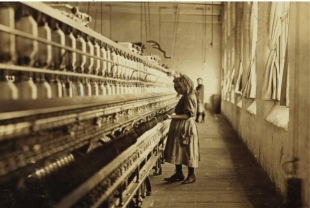
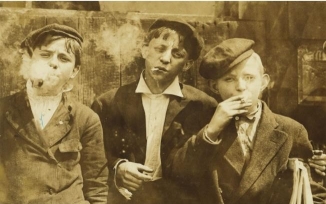
How might Progressives' reactions to Lewis Hine's "Sadie Pfeiffer, Lancaster Cotton Mills, South Carolina" have differed from their reactions to his photo "Newsies Smoking on a Monday Morning, St. Louis, Missouri, 1910"?
A) Progressives probably would have been angry that the little girl was standing idle but amused at the young boys' antics.
B) Progressives probably would have been accepting of the little girl's working under adult supervision but angry that three young boys were working without such supervision.
C) Progressives probably would have felt protective of the little girl working practically alone in the big factory but would have been upset by the vice of the young boys.
D) Progressives probably would have feared what the future held for the young boys but would not have been as concerned about the future of the little girl.

Unlock Deck
Unlock for access to all 50 flashcards in this deck.
Unlock Deck
k this deck
40
Why did temperance organizations like the Anti-Saloon League and the Women's Christian Temperance Union appeal to rural residents of this country?
A) They were concerned about the influence of urban pleasures and beer-drinking immigrants.
B) There was a serious problem with the production and sale of moonshine liquor in rural areas.
C) Saloons contributed to the nation's troubles with labor by providing a place for unions to meet.
D) Saloons served as headquarters where dishonest urban politicians paid immigrants for votes.
A) They were concerned about the influence of urban pleasures and beer-drinking immigrants.
B) There was a serious problem with the production and sale of moonshine liquor in rural areas.
C) Saloons contributed to the nation's troubles with labor by providing a place for unions to meet.
D) Saloons served as headquarters where dishonest urban politicians paid immigrants for votes.

Unlock Deck
Unlock for access to all 50 flashcards in this deck.
Unlock Deck
k this deck
41
When Booker T. Washington stated in his 1895 "Atlanta Exposition Address" that "the opportunity [for blacks] to earn a dollar in a factory just now is worth infinitely more than the opportunity to spend a dollar in an opera house," he believed that race relations would improve if
A) African Americans focused on economic advancement and remained patient
B) African Americans defended themselves with rifles
C) African Americans left the United States
D) white Americans understood the poverty in which many African Americans lived
A) African Americans focused on economic advancement and remained patient
B) African Americans defended themselves with rifles
C) African Americans left the United States
D) white Americans understood the poverty in which many African Americans lived

Unlock Deck
Unlock for access to all 50 flashcards in this deck.
Unlock Deck
k this deck
42
What was black journalist Ida B. Wells-Barnett referring to when she declared that "a Winchester rifle should have a place of honour in every black home, and it should be used for the protection which the law refuses to give"?
A) resistance to lynch mobs
B) boycotts of white-owned railroads
C) desegregation of public facilities
D) overturning of Jim Crow laws that denied voting rights to blacks
A) resistance to lynch mobs
B) boycotts of white-owned railroads
C) desegregation of public facilities
D) overturning of Jim Crow laws that denied voting rights to blacks

Unlock Deck
Unlock for access to all 50 flashcards in this deck.
Unlock Deck
k this deck
43
What governmental issue was championed, although for different reasons, by both Progressives and socialists?
A) the federal regulation and inspection of meat
B) the creation of city-run utilities
C) the use of violent strikes by urban workers
D) desegregated facilities for African Americans
A) the federal regulation and inspection of meat
B) the creation of city-run utilities
C) the use of violent strikes by urban workers
D) desegregated facilities for African Americans

Unlock Deck
Unlock for access to all 50 flashcards in this deck.
Unlock Deck
k this deck
44
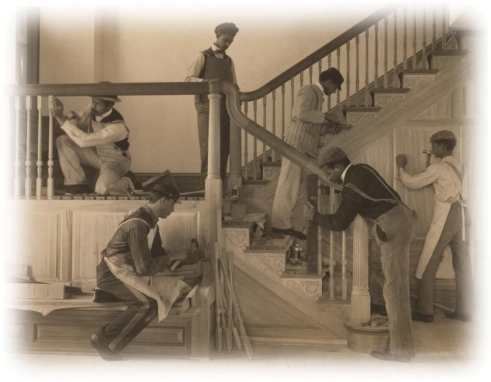
How does this photograph of a carpentering class at the Hampton Institute reflect Booker T. Washington's ideas of how African Americans should achieve success?
A) It fosters an image of African Americans as superior craftsmen.
B) It calms the fears of white supremacists by showing blacks working menial jobs.
C) It shows young men working at a trade school to gain skills necessary for advancement.
D) It shows young men silently demonstrating their fitness to attend a desegregated school.

Unlock Deck
Unlock for access to all 50 flashcards in this deck.
Unlock Deck
k this deck
45
The successful passage of the initiative, referendum, and recall by Progressive lawmakers resulted in .
A) the establishment of strong mayors at the municipal level
B) greater civil rights for African Americans
C) enactment of more conservative legislation
D) the reduction of power of corrupt political parties and officials
A) the establishment of strong mayors at the municipal level
B) greater civil rights for African Americans
C) enactment of more conservative legislation
D) the reduction of power of corrupt political parties and officials

Unlock Deck
Unlock for access to all 50 flashcards in this deck.
Unlock Deck
k this deck
46
What did the Seventeenth Amendment do?
A) It made the distribution and use of alcohol illegal.
B) It provided for the direct popular election of U.S. senators.
C) It limited presidential terms.
D) It gave women the right to vote.
A) It made the distribution and use of alcohol illegal.
B) It provided for the direct popular election of U.S. senators.
C) It limited presidential terms.
D) It gave women the right to vote.

Unlock Deck
Unlock for access to all 50 flashcards in this deck.
Unlock Deck
k this deck
47
What did W. E. B. Du Bois mean by the "Talented Tenth"?
A) those Americans who, like him, attended elite schools such as Harvard
B) those African Americans whose intellect and skills were never discovered or cultivated
C) an elite set of African Americans for whom segregation should not apply
D) an educated elite of African-American professionals and teachers
A) those Americans who, like him, attended elite schools such as Harvard
B) those African Americans whose intellect and skills were never discovered or cultivated
C) an elite set of African Americans for whom segregation should not apply
D) an educated elite of African-American professionals and teachers

Unlock Deck
Unlock for access to all 50 flashcards in this deck.
Unlock Deck
k this deck
48
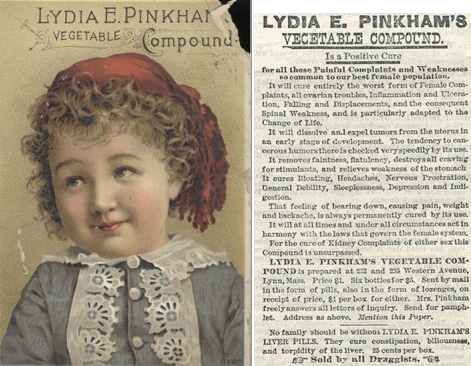
As a result of the Pure Food and Drug Act that required manufacturers of patent medicines to list all ingredients, what ironic element did female Progressives who widely used Lydia E. Pinkham's Vegetable Compound, a popular cure-all tonic for women, discover?
A) The compound actually contained 15 percent alcohol.
B) The syrup was made with more sugar than vegetables.
C) The formula essentially was composed of male hormones.
D) The mixture really did restore a person's physical beauty.

Unlock Deck
Unlock for access to all 50 flashcards in this deck.
Unlock Deck
k this deck
49
As a result of journalist David Graham Phillips's investigative article entitled "The Treason of the Senate," President Theodore Roosevelt began to call such journalists .
A) "mugwumps"
B) the "Talented Tenth"
C) "muckrakers"
D) socialists
A) "mugwumps"
B) the "Talented Tenth"
C) "muckrakers"
D) socialists

Unlock Deck
Unlock for access to all 50 flashcards in this deck.
Unlock Deck
k this deck
50
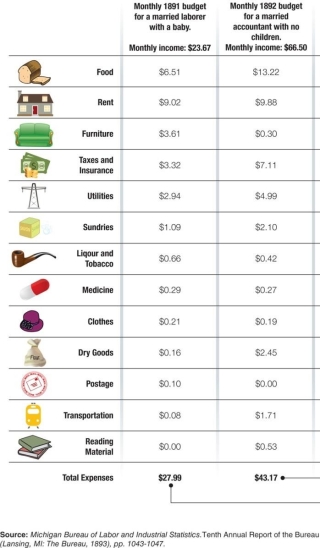
What do these budgets reveal about lifestyles for urban laborers and professionals in the 1890s?
A) Urban laborers ate healthy foods and had a good diet.
B) Expenses for urban laborers outweighed the income of one male wage earner.
C) Most professional workers lived within the urban center of cities.
D) Living conditions in rental units were similar for urban workers and urban professionals.

Unlock Deck
Unlock for access to all 50 flashcards in this deck.
Unlock Deck
k this deck



